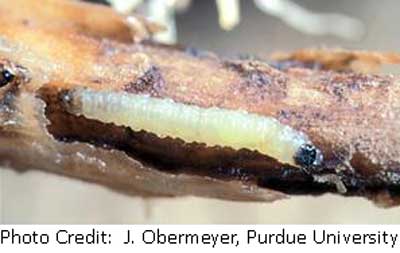
- Hatch of corn rootworm larvae is driven by accumulated degree days.
- Peak hatch occurs in early June across most of our Midwest trade territory.
- Mid-to-late June is the time to actively scout for rootworm larvae and feeding damage.
- Scouting larvae is time-intensive, target your initial scouting to higher risk fields.
Why to Scout
Both adult and larval forms of corn rootworm can cause significant crop damage. Larvae feed on corn root hairs and roots, and develop through three instars phases before pupating into adult beetles. Larvae rob the plant of valuable water and nutrient flow and put the corn under yield-reducing physiological stress. Feeding sites on the plant are also a common pathway to infection by pathogenic diseases, which can further compromise stalk integrity later in the season.
When to Scout
Female western and northern corn rootworm beetles lay eggs in the soil in the late summer. The eggs overwinter and begin to hatch when sufficient soil growing degree days have accumulated through the spring. Iowa State University research suggests that 50% egg hatch occurs between 684-767 accumulated degree days (base 52 F, soil). Rootworm hatch is often thought to coincide on the calendar with lightning bug activity, but this indicator is far less reliable than degree days. Peak hatch normally occurs in June across our Midwest trade territory, so June marks the beginning of the period of time to actively scout for corn rootworms and evaluate their feeding damage.
Where to Scout
Scouting larvae can be labor-intensive and costly, so we recommend targeting your scouting activity to those fields which are known to be at greatest risk for infestation. Higher risk fields include corn following corn rotations, fields with high populations of adult beetles the previous August (including previous year soybean fields for variants), weedy fields, hybrids with single corn rootworm traits, fields with a history of performance issues with either soil insecticides or traits or both. Because adult beetles are mobile, fields adjacent to these areas can also be at risk for rootworms. Aerial imagery collected by UAV can be helpful for identifying field areas with root lodging for targeted scouting. Be aware that corn does not have to be obviously lodging to have serious root damage, so don't be complacent based on good appearance, as you could have a growing problem going undetected.
How to Scout
Larvae of both western and northern species are very difficult to tell apart. Both are slender white and small (1/2" or 13 mm), with a brown head and a dark tail plate (see photo). Dig one plant from each of several representative locations in the field. Dig a 7"x7" cube of soil surrounding the roots and lift the entire plant and root mass out of the ground undisturbed. Gently break away the soil from the root system over black plastic and attempt to visually identify the white rootworm larvae against the black background. Larvae can be difficult to find by hand-sorting soil, and you may have better success immersing the roots and soil in a bucket of water and floating the larvae to the surface. Count the larvae for each plant and average across all plants. Economic thresholds are two (2) larvae per plant with the black plastic method or eight (8) larvae with the wash and float method (Source: Purdue University). If you find threshold numbers of larvae in higher risk fields, expand your sampling net to look at other fields. Unexpected rootworm activity on rootworm-traited hybrids or with insecticides could signal a resistance issue – please notify your FS Crop Specialist in those circumstances.